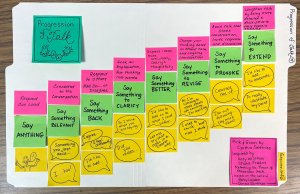Teaching Students How to Have an Academic Discussion
This teacher-created scaffolding tool can elevate classroom dialogue, empowering students to express themselves while learning from the ideas of others.
Your content has been saved!
Go to My Saved Content.Ever been in the midst of a classroom discussion where students are bubbling over with ideas, eager to share? It can look and sound like lots of voices calling out and talking over each other while quieter students try to find a place to enter the fray. You don’t want to squash anyone’s enthusiasm, but how do you ensure that every student has the opportunity to truly express themselves and hear the ideas of their classmates?
Students’ ability to clearly communicate with others in conversation is a critical literacy skill. While goals for speaking are a part of elementary school standards, beginning in kindergarten, teaching talk can feel tricky; it’s often hard for students to know where to begin or the next best place to go when responding to someone. A “Progression of Talk” chart can be very helpful in this work—defining starting and ending points for students, as well as all the points in between, when engaging in conversation.
The “Progression of Talk,” by Cynthia Satterlee, begins with a student saying anything at all and grows to a student saying something relevant, adding on to what was previously said or disagreeing, clarifying, improving, revising their thinking, provoking more thought, or extending and elaborating—all necessary skills for any form of discourse.
When Cynthia shared this progression during a workshop, I nodded and thought, “Yes, just what I’ve been looking for!” She helped me see how talk could grow across a range of grade levels and subject areas. As I studied the progression, I thought it could become an even more powerful tool for students and teachers by adding a series of sample talk prompts at each level.

Observation
The first step of teaching kids how to lift the level of their talk begins with observation: simply paying attention to what students are saying to each other. Is it connected to the original speaker’s sentiments or wildly off-topic? Are they putting thoughts into words and able to keep a conversation going or inadvertently shutting it down? Match your observations to steps on the progression and then lean into instruction.
What this looks like inside the classroom:
Many elementary-aged children love to share their opinions when they disagree with others. I have heard children do this with short phrases—“That’s not right!”—or by sharing how they see things differently without acknowledging the original speaker’s ideas.
- Providing students with talking prompts like “I agree…” or “I feel differently…” can help them make a connection between what the speaker is saying and what they are adding to grow the conversation.
- Similarly, empowering kids to use the phrase “I’d like to add…” helps build a bridge from someone else’s idea to their own.
Introducing Talk Prompts
Displaying talk prompts once you have introduced them to your class can be a powerful scaffold. It’s best to write them with students while explicitly explaining the thought process behind the prompts:
“One way we are adding on to what other kids in class have to share is to start by saying, ‘Something you just said…’ Let’s write that on a big sticky note and place it here on the board where we can all see it. We can work on growing our talk by using this language whenever we want to share something connected to the conversation.”
This note can then be referred to prior to conversations, with a reminder: “Remember, we are trying to grow our talking skills by saying something that connects to what the person before you said.”
Next, point to and provide the talk prompts to help scaffold this work. Slowly building a progression tool with students is much more powerful than displaying it in its entirety at the onset of digging into these skills.
The Evolution of Talk
This process takes time. Support conversations with the talk prompts until students make them their own. If a child begins speaking without them, you can gently say the prompt and encourage them to try again, scooping up this language as their running start. When I am doing this, it reminds me of helping someone learn how to float. At first, my hands are firmly under the person, but soon my words become gentle fingertips just beneath the surface—providing reassurance, stability, and support.
I take my figurative hands completely away when I hear kids incorporating the language of this progression in natural back-and-forths. This might sound like a child adding on to something they’ve said to clarify a point—“Let me try to say that in a clearer way” or “I’d like to add on to what I said before.” And another child sharing how their thinking has changed as a result of considering the thoughts and perspectives of others—“I used to think… but now I think…”
Not only does this exchange sound good, but it honors the thoughts of all speakers and helps kids see how their words are interconnected.
It’s important to remember that this progression chart isn’t a set of discrete steps or tied to particular grade levels; it can be more fluid depending on what students are saying, how they are interacting, or the focus of your curriculum. For example, with fifth graders in a debate unit, lean into talk prompts that allow students not only to press for more information but to respectfully express differing viewpoints.
As kids grow in this work and try on other successful ways to lift their talk, notice, name, and celebrate what they are saying, then add it to your shared chart. Empower students to use this cocreated visual to gauge their own progress, connect their language to the progression, and set goals to grow. Elevating talk skills in a dynamic way enables students to truly express themselves both in and out of the classroom, shifting responses like “What?!” to “I’d love to hear you say more…”
